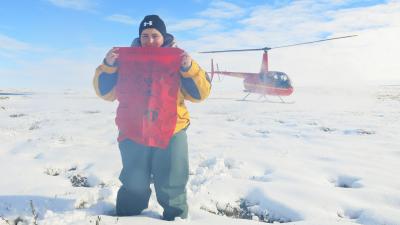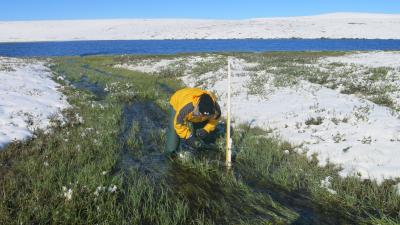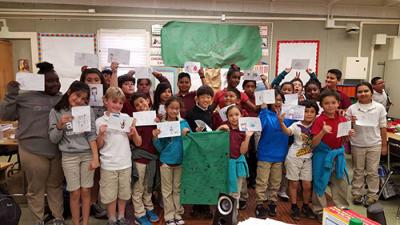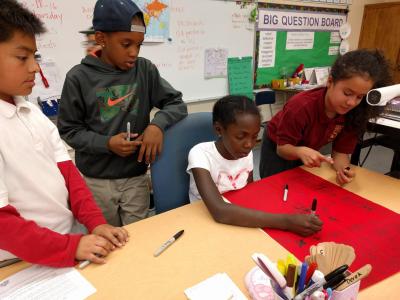Microbial Changes in Arctic Freshwater 2016
I love polar science and I knew that I wanted to travel to a polar region and work on translating some of the current polar science into teachable lesson plans so I can share my passion with the masses, especially my STEM (Science Technology Engineering and Math) students in the three programs that I manage. I went into the field of polar research so that the content that is delivered to students is up to date and relevant to what is going on now. I was motivated to apply to PolarTREC (Teachers and Researchers Exploring and Collaborating) because I believe field study is an integral part of learning and integrating science into a classroom or education program. I want to be a model for my students; I want to show them that research and education go hand in hand and that there are innumerous opportunities to apply what is learned in the classroom in the real world.
Microbial Changes in Arctic Freshwater 2016 Expedition Activities
As a 2016-2017 PolarTREC teacher I was paired with Dr. Byron Crump from Oregon State University. I met Dr. Crump in person for the first time in May 2016 to see what his research was all about. His research focuses on how microbe ecology changes across the Arctic tundra. Microbes are indicators of environmental change because the diversity or kinds of microbes change in response to environmental changes.
Our research focused on microbial ecology of the Arctic tundra ecosystem. The results could improve our understanding of the Polar Regions by addressing the impact of microbial ecology on the Arctic tundra, specifically the permafrost. Permafrost is permanently frozen soil or rock that remains at 0°C for at least two years. 
Dr. Crump is looking at natural microbial diversity to see if it can provide clues about climate change and warming, and its impact on the ecology of the Arctic tundra. With the ongoing increase in global temperature, permafrost soils are thawing, which allows microbes to access the organic carbon in soils. Consequently, they consume it and respire, which produces greenhouse gases such as carbon dioxide and methane. The concern is that these greenhouse gases will be released to the atmosphere at such a high rate that it will accelerate global warming in a positive feedback causing even more permafrost to thaw in the Polar Regions.
Microbes are perpetrators of climate change in the Arctic. They convert soil carbon into CO2 but different microbes do that job in different habitats. Streams, lake and soil microbial communities are made up of very different species, and those species can be identified like a fingerprint. These fingerprints are defined through DNA. These habitats (soil, stream and lake) are connected, and Dr. Crump’s team is trying to see how these communities interact as different species wash down watersheds from soils to streams to lakes to the ocean. 
The research goal includes understanding how environmental factors such as temperature and water flow control the activity of these microbes, and how the species diversity of microbes interacts with these controls and may change in the future. The most important thing I learned about arctic microbes is that the streams are continuously bringing in the soil bacteria and as they flow down the watershed.
Dr. Crump’s lab is demonstrating this microbe identification and diversity process is changing across the watershed on different scales. The Crump lab is looking at how microbe populations are different (diversity/numerically) in the lakes, streams and soils and what impact their movement through a particular area has on climate change. 
One of the research tasks that I was involved in while at Toolik Research Station was collecting water from both the lakes and streams. We processed the water samples by filtering them with a very small filter (0.2 microns) to catch the bacteria.
Back in the lab at the field station, the samples were processed. This is done by removing the filter paper and cutting them up into smaller sizes. Afterwards, several steps are taken to extract the DNA from the filters. Sample tubes are sent to Dr. Crump’s lab where they are further processed and the ‘fingerprint genes’ in the DNA are amplified (make lots of copies) and then sent out for sequencing. Dr. Crump does this so that he can quantify the types of bacteria found in each of the water samples representing each of the lakes and streams to address the water connectivity research question.
Based on this study, the researchers have found out that microbes in streams and lakes have the genetic capabilities to turn permafrost carbon into CO2 as more and more of this permafrost carbon is moved from soils to streams to lakes. This is not a good thing because it adds to the “positive feedback loop”. A positive feedback loop is process in which an initial change will bring about an additional change in the same direction. In this case, the positive feedback loop in the Arctic tundra is more permafrost (or frozen carbon) thawing, more CO2 and other heat trapping gases like methane being created by the microbes, and continuing the greenhouse gas emissions that are warming the planet and causing further damage to the Earth.
I wanted to work with researchers like Dr. Crump to see for myself the impacts of climate change on the Arctic so that I can better explain this science to my students. I think it’s important as a STEM (Science Technology Engineering and Math) educator to know what science is currently happening in our world so that the content that is provided to students is relevant for their future careers in STEM (Science Technology Engineering and Math).
STEM Outreach
The research experience was incredible and fascinating and provided me with the opportunity to see changes occurring on our planet firsthand. I loved working with all of the amazing scientists at Toolik that are quantifying the environmental changes to the Arctic. 
My polar experience will be shared with the USC Wonderkids Program, USC NAI program, and the USC Young Scientists Program (YSP). I wrote a polar curriculum to share with other teachers including Rossier STEM (Science Technology Engineering and Math) teachers. Polar science lessons are aligned with the NGSS standard on humans required for YSP curricula, and will reach 1400 low-income and underrepresented students in science in 4th and 5th grade through this program. Wonderkids focuses on different fields of science and covered polar science with this age group. Wonderkids hosted four polar scientist-speaking engagements either virtually or in person and this program brought in polar scientists and other PolarTREC teachers.
Before I left for the expedition, I had 1500 of my YSP students write Arctic postcards with questions about the research that I was doing and create a polar flag that represented their classroom. I answered, returned, and documented all 1500 postcards. Furthermore, I posed with their polar flags everyday of my Arctic journey so that they could feel like they were a part of my expedition too. 
Furthermore, I also performed Polar outreach at the Diamond Bar Earth Day event and in the classroom of my nieces and nephews at Susan B. Anthony School. I also created a polar activity and presented the Extreme Cold Weather gear at the USC SCOUT (Science Outreach) Science Fair.
After I returned from the expedition, I also submitted proposals and presented at various conferences including the American Geophysical Union (AGU) in San Francisco, California, and at the North American Association of Environmental Educators (NAAEE) in Madison, Wisconsin with fellow PolarTREC teacher Karen Temple-Beamish.
I used social media throughout my PolarTREC journey and all together I reached 16,044 people through all of my posts. The most highly viewed post with over 2000 people having seen it was the Dancing Scientists Video.
It has been an amazing adventure in the Arctic. One of my favorite experiences was flying to the nearby lakes to collect water samples in a helicopter. I feel so fortunate to have been a part of such a fantastic science field experience and worked with amazing researchers from all over the country and the world. I learned so much about polar science and the impact that microbes have on our environment.
| Attachment | Size |
|---|---|
| Download Report (984.06 KB)984.06 KB | 984.06 KB |
This program is supported by the National Science Foundation. Any opinions, findings, and conclusions or recommendations expressed by this program are those of the PIs and coordinating team, and do not necessarily reflect the views of the National Science Foundation.
